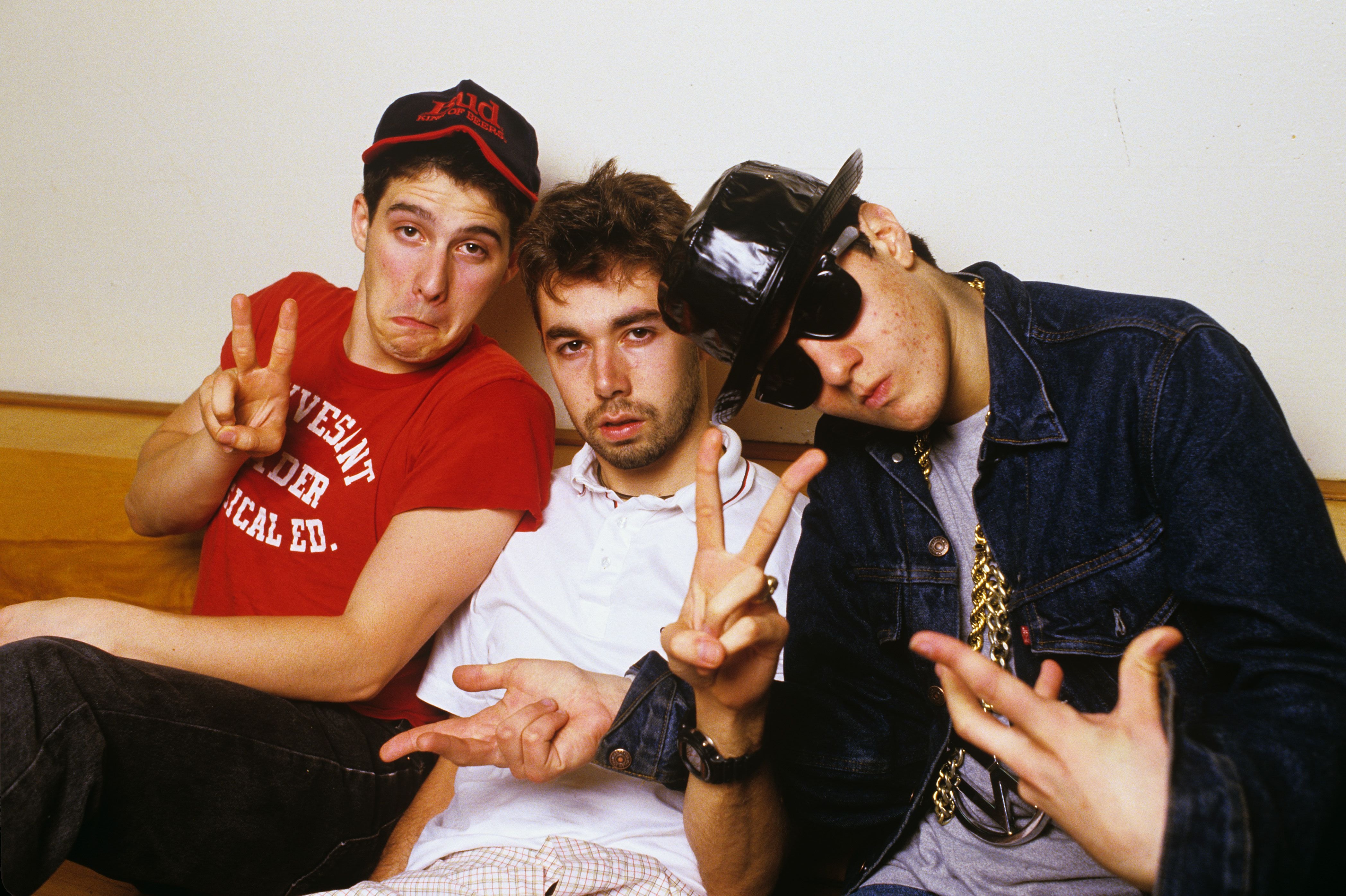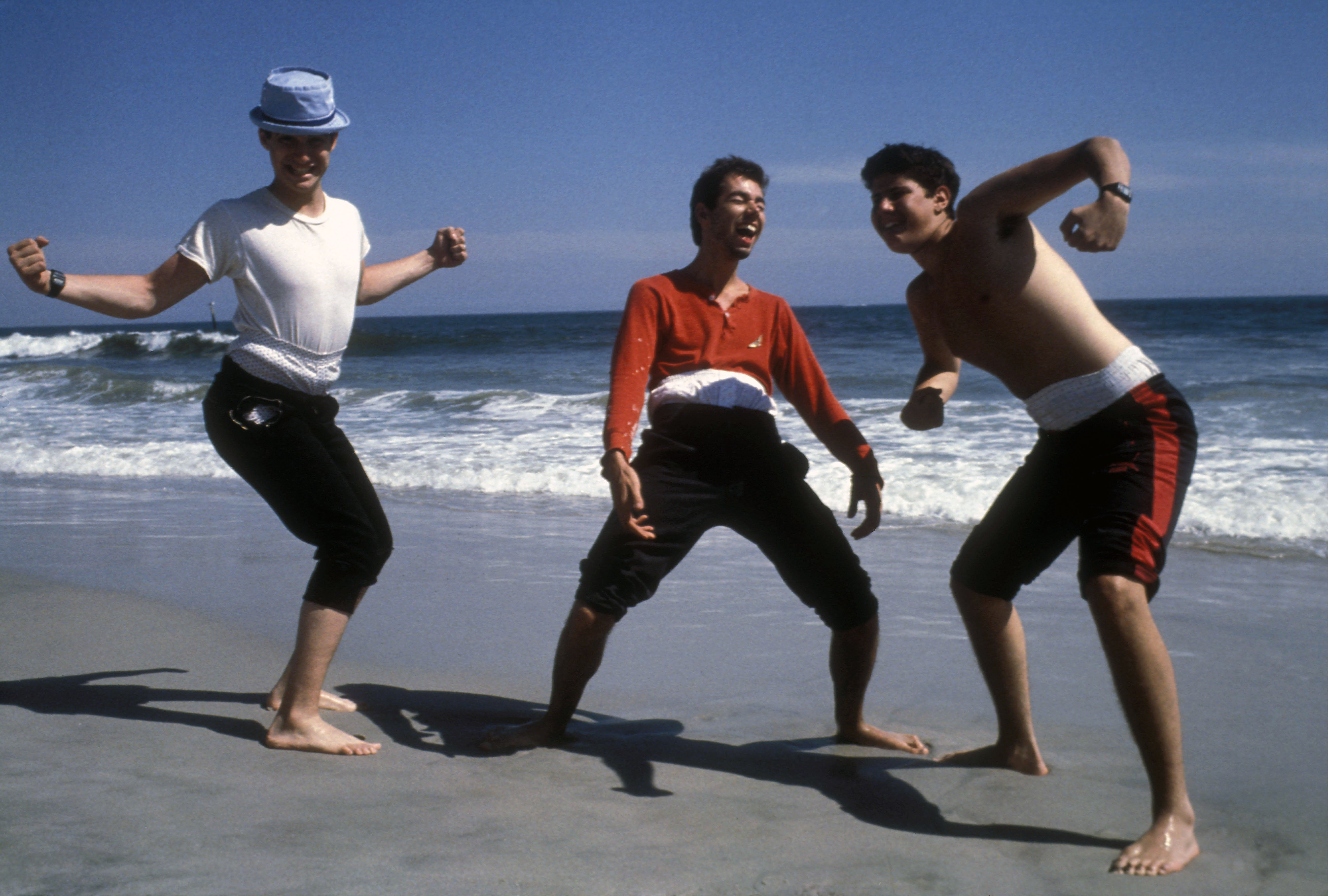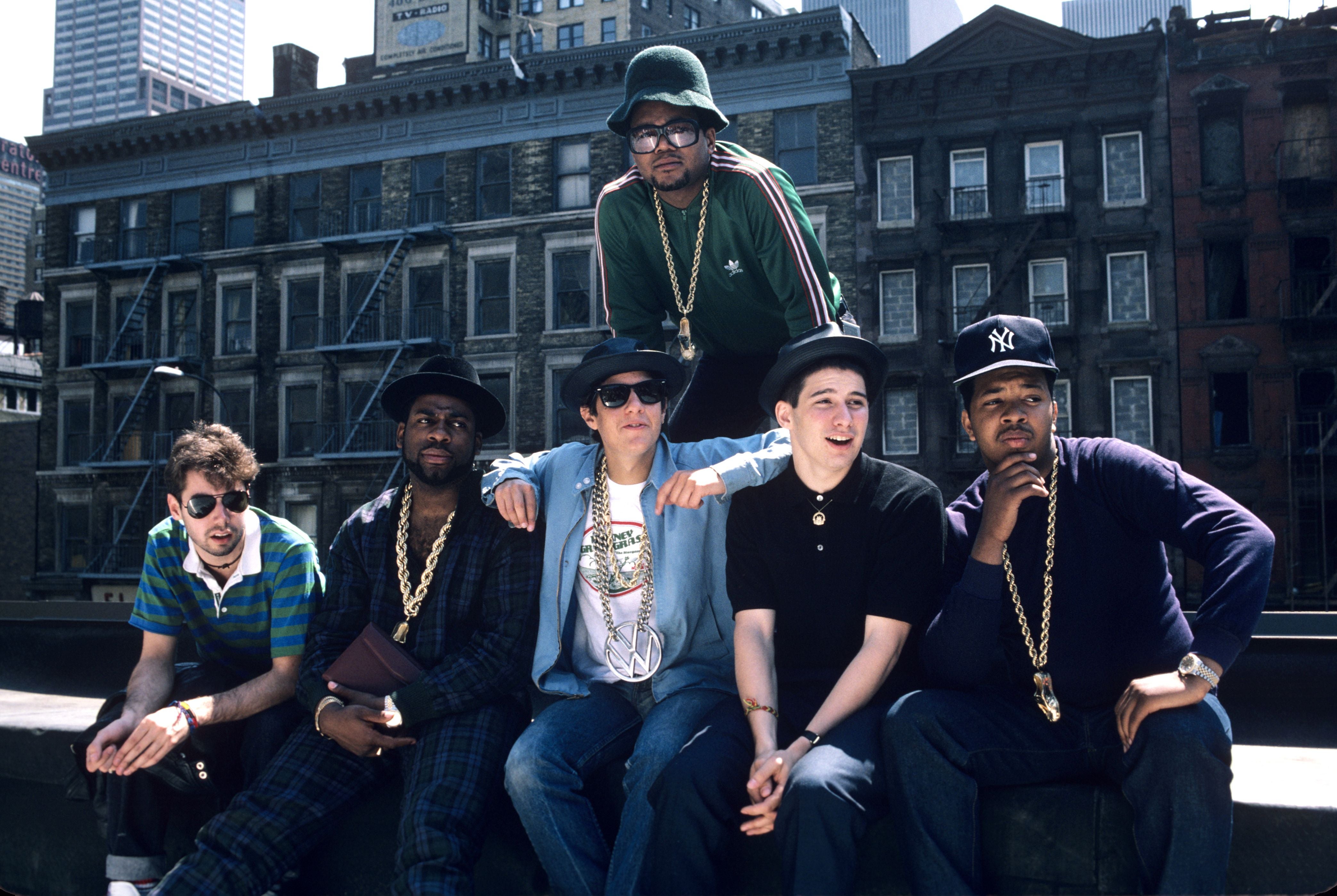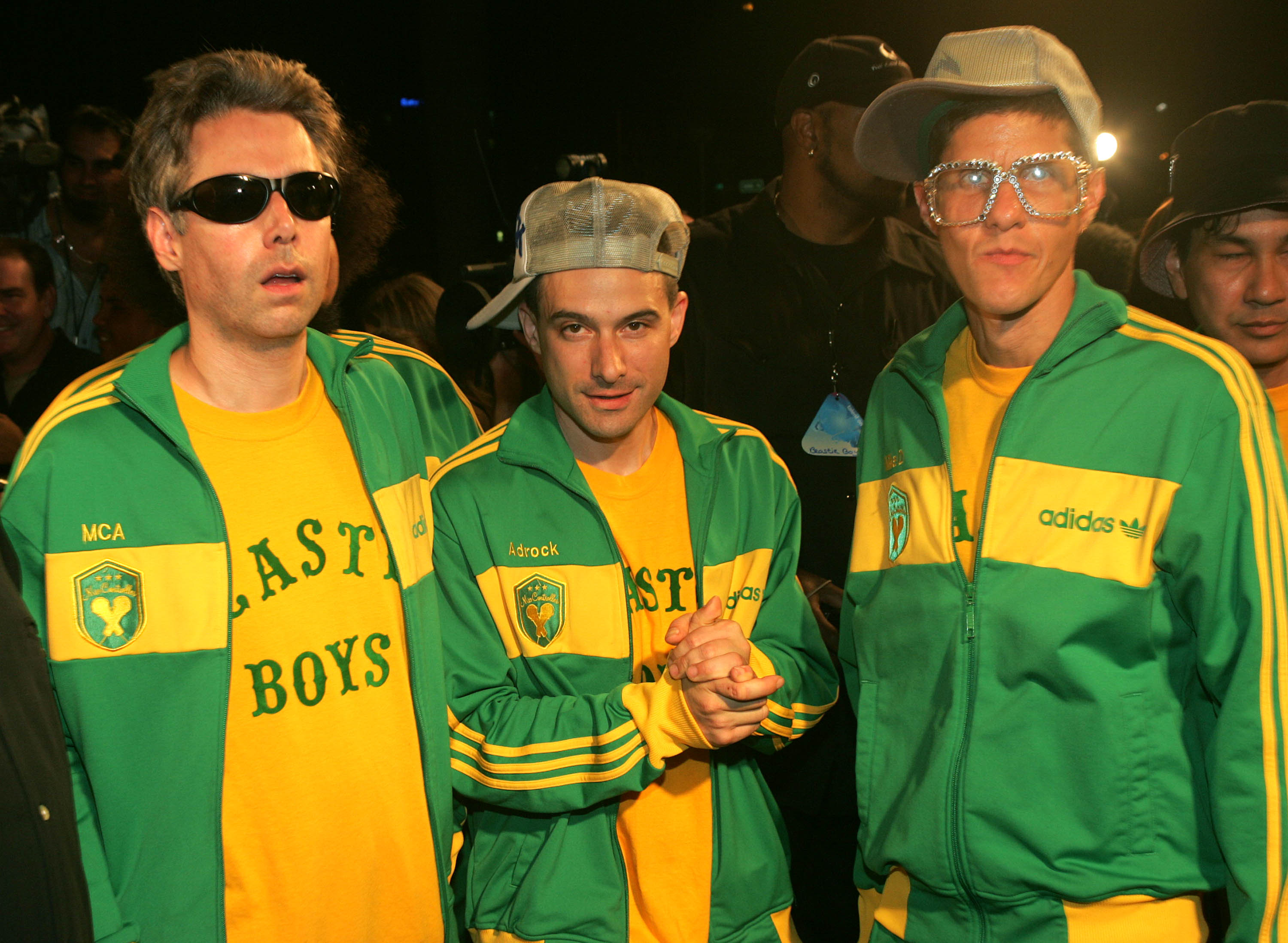Memorable jerks: How the Beastie Boys were almost lost in the shadow of a 25ft d***
The first white rap superstars looked like a flash in the pan when they started living up to their obnoxious party bros image. Mark Beaumont explores how these three New York punks made it from pop gatecrashers to music’s hall of fame

Your support helps us to tell the story
From reproductive rights to climate change to Big Tech, The Independent is on the ground when the story is developing. Whether it's investigating the financials of Elon Musk's pro-Trump PAC or producing our latest documentary, 'The A Word', which shines a light on the American women fighting for reproductive rights, we know how important it is to parse out the facts from the messaging.
At such a critical moment in US history, we need reporters on the ground. Your donation allows us to keep sending journalists to speak to both sides of the story.
The Independent is trusted by Americans across the entire political spectrum. And unlike many other quality news outlets, we choose not to lock Americans out of our reporting and analysis with paywalls. We believe quality journalism should be available to everyone, paid for by those who can afford it.
Your support makes all the difference.They were every teen rebel’s dream, every parent’s worst nightmare. As MCA, Ad-Rock and Mike D kicked down the door of a nerdy house party and set about stealing valuables and girlfriends, spitting beer in people’s faces, spiking the punch with aphrodisiacs, smashing TVs and instigating the mother of all custard pie fights, they also gatecrashed mainstream pop culture with mayhem on their minds. Beastie Boys were in the house.
The video for the trio’s breakout single “(You Gotta) Fight for Your Right (to Party!)” – the fourth single from their 10 million selling 1986 debut album Licensed to Ill, released 35 years ago this week – swallowed MTV like a shotgunned Budweiser, then crushed the charts against its forehead with a roar. Hard on the heels of Run-DMC. and Aerosmith’s collaboration on “Walk This Way”, the song brilliantly serviced the public craving for further rock-rap crossover, making the US Top Ten. And the video introduced the world to its new youth threat: delinquent skate kids in baseball caps and shades shouting about truancy and smoking, dripping gold chains, VW badge medallions and hedonistic abandon. National Lampoon’sAnimal House with a backbeat; rap’s own goof-jock Sex Pistols.
The image, and the song, were in-jokes. Written by MCA (aka Adam Yauch) and his friend Tom Cushman as a parody of frat-boy culture, it hit home with precisely the audience it was satirising. “They made that song as a joke, a fake anthem making fun of party bros and frat guys,” Adam Horovitz (Ad-Rock) claimed in Spike Jonze’s live documentary Beastie Boys Story last year. “There were tons of guys singing along to ‘…Fight for Your Right…’ who were oblivious to the fact it was a total goof on them,” Michael Diamond (Mike D) confirmed in 1987.
By which time the joke was entirely on them. As Licensed to Ill shot to the top of the Billboard chart and its confrontational tour made them Public Enemy Number One – its beer-spraying antics, go-go cage and giant hydraulic phallus inspiring scandalised tabloid headlines, lawsuits, riot and arrest – Beastie Boys found themselves sucked inescapably into their own parody skit, unable to tell what was truth or humour. It was the classic recipe for flash-in-the-pan pop outrage, yet Beastie Boys were that rare band of fighters with the talent to turn such an infamous introduction into the foundation of one of the most feted and pioneering careers in rap history.
“They weren’t jocks at all,” says photographer Glen E Friedman, whose pictures of the band and close associates Run-DMC. from the period were collected into 2019’s book Together Forever. “They were artists, they were just having fun. The whole thing was a joke... It was abstract to them, the whole thing. You could look at it almost like an abstract art piece, the whole band.”
“I don’t think they could have stayed that band forever,” says Adam Dubin, co-director of the “(You Gotta) Fight for Your Right (to Party!)” video. “I don’t think they particularly wanted to, because I think they developed the confidence to move past all of it. I think they became the better version of themselves [and] if you’re confident you don’t need all that kind of staging that is looking to court controversy. Knowing those guys, that’s really not who they were.”
As college roommate of fellow rock fanatic Rick Rubin at NYU in the early Eighties, Dubin had run into the nascent Beastie Boys at all-ages matinee shows in their days as teenage hopefuls on the New York hardcore punk scene. “I was aware of this gang of kids,” he says, “like New York skate kids. You’d see them at all the shows… They would run around New York City, sometimes with skateboards or not, this group of punk kids. There was a lot of others too, nobody would have singled out those three guys saying, ‘there’s the future Hall of Fame.’”
Yauch and Diamond had met at a Bad Brains show; Horowitz claims he first ran into them both in the ladies’ toilet of a gig by the Misfits. An initial incarnation of Beastie Boys, featuring Yauch, Diamond, schoolfriend John Berry on guitar and future Luscious Jackson drummer Kate Schellenbach at the kit, had been playing low-key shows for a year before Horowitz left his band The Young and the Useless to replace Berry in 1982. “We were Monty Python as much as we were Black Flag,” Diamond confesses in Beastie Boys Story, and Friedman agrees.
“I really didn’t think they were a very good punk rock band,” he says. “They were corny to me. I took an affront to them being pranksters, that was their whole thing. That’s always been their thing. I took this very seriously. So as an audience member at a punk rock show, with those guys opening for the Bad Brains, third or fourth on the bill, I just walked outside when they started throwing marshmallows at the crowd.”
Enjoy unlimited access to 100 million ad-free songs and podcasts with Amazon Music
Sign up now for a 4 month free trial (3 months for non-Prime members)
Enjoy unlimited access to 100 million ad-free songs and podcasts with Amazon Music
Sign up now for a 4 month free trial (3 months for non-Prime members)
Dubin, however, recalls the febrile energy of their punk shows. “When I saw them, it was wild. They would jump around onstage, which was great. They’re not playing that well, they’re not singing that well, they’re kind of belting it, but the energy is unmistakable. That’s what they brought to the rap stuff that they started to do.”

Behind the punk bawling of their 1982 debut EP “Polly Wog Stew”, Beastie Boys were becoming increasingly enthralled by the early rap releases of Kurtis Blow, DJ Kool Herc and Afrika Bambaataa. To the extent of releasing a novelty rap track in 1983 called “Cooky Puss”, based around a prank phone call to an ice cream chain advertising the titular innuendo-friendly product. The single’s underground success – and the arrival of Run-DMC.’s “Sucker M.C.’s” – prompted an abrupt stylistic shift for the Beastie Boys; they would be the first white rap group.
“We didn’t even question us being white and rapping,” Diamond told Vice News in 2018 when challenged over “cultural appropriation”, “we just loved rap music and said, ‘we’re gonna make that.’”
On the hunt for a DJ to help them realise their new direction, someone suggested a guy who owned a bubble machine, who turned out to be none other than Rick Rubin, himself turned on to the crossover potential of rap music. Rubin quickly became the group’s loudest champion. “Rick Rubin very rightly identified [rap] as a new form of punk in that it was sort of do-it-yourself and self-created,” says Dubin. “He had already foreseen what would become ‘Walk This Way’, this collision of hard rock culture that was building in rap, that rap wasn’t just something that was limited to an African-American audience.”
Adopting Rubin’s apartment as their unofficial HQ and now playing half rock, half rap gigs, Beastie Boys watched on as Rubin met with Run-DMC. manager Russell Simmons and launched Def Jam Recordings in 1984, with LL Cool J and Beastie Boys as the label’s hottest initial signings. “They wanted us to be a cartoon rap version of an ’80s metal band,” Diamond explained in Beastie Boys Story. “And we were all in,” Horovitz added.
Since she didn’t fit the tough hip-hop look the Beastie Boys wanted to project in Run-DMC’s image, Schellenbach was summarily ejected from the band, and the remaining trio soon upped their lad-rap game. Booked to support Madonna on their first ever tour in 1985 (because Run-D.M.C. were too expensive), they came up with what Diamond called “a brilliant plan” to make Madge’s audiences remember them. “Our big idea was we should be as rude and as awful as possible onstage… We’d be memorable. Memorable f***in’ jerks.”
Taking presentation pointers from professional wrestling, the Beastie Boys became testosterone tornados. They told Madonna’s fans to burn venues to the ground once they’d left the stage and, while supporting Run-DMC. in Miami, invaded the stage during Aerosmith’s guest appearance on “Walk This Way”. When Rubin, producing Licensed to Ill, “took our weird rap songs and made them sound clean and big and polished and ready for the radio”, the Beastie Boys very nearly scuppered the record’s success by suggesting it be called Don’t be a F*****.
It was this Butthead baiting attitude which was encapsulated in “(You Gotta) Fight for Your Right (to Party!)” – released a month after Licensed to Ill in December 1986 – and in the video which MTV demanded once the track started lighting up switchboards at every radio station in America.
“Every market we would hear phone calls coming back,” Dubin recalls, “they played it at a radio station in Detroit and the phones lit up and everybody wanted to know what the hell is that, who are those guys and when are you going to play it again? That was starting to come in from all these places around the country… Some suits came down from MTV. They were saving a slot in in heavy rotation, which was more than gold at that moment in time, if we don’t have a music video they’re gonna give that slot to somebody else.”
Things in Camp Beastie got real professional real quick. Holed up in Diamond’s apartment to brainstorm video ideas, Dubin’s co-director Ric Menello suggested an update of the chaotic party scene in Breakfast at Tiffany’s. “The party devolves from a classy New York party to everybody’s drunk and out of control and the police raid the place,” Dubin says. “So, once we had that breakthrough that the Beastie Boys raid this party, it was just off to the races. We wrote a million gags and made it a gagfest.”
They could be a bit wild when they were hanging out and going to clubs, drinking and carrying on. But working with them, they were very focused
Borrowing a photographer’s apartment, filling it with friends including Rubin, LL Cool J and Flea from Red Hot Chili Peppers and bringing in their own TVs and guitars to smash, Menello and Dubin – both first time video directors Rubin knew from film school – made the now legendary promo in two days on a shoestring, shooting at breakneck pace. “It was actually very organised,” Dubin says of the on-screen chaos. “Everybody just did what they were told. They could be a bit wild when they were hanging out and going to clubs, drinking and carrying on. But working with them, they were very focused… I remember [them] arguing over who got to throw the pie at Rick Rubin, they all wanted to hit him with a pie [but] they didn’t go out and tear it up that night, they knew they had to be on set the next day at eight o’clock because we had to get this thing.”
Even as a spoof, the video crystallised the Beastie Boys’ obnoxious new persona, equal parts John Belushi, Run-DMC., Mötley Crüe and the Three Stooges. “They’re the guys who show up at your party, they’ll drink your beer, they’ll take your girls and they will leave before trouble comes, whether that’s police or parents coming home,” says Dubin. “They’re a bit wild and out there, but in a sense also good-natured. They cause a bit of mayhem but they didn’t burn the place to the ground, they just messed it up and then left. And I think that created an identity for them. Two weeks later, that thing was on MTV and it started going bananas.”
The video instantly “blew up” and, as Licensed to Ill became the first rap album to top the Billboard chart, uniting a generation of rap-rock rebels and making international superstar anti-heroes of the Beastie Boys, they threw themselves wholeheartedly into the cartoon. The video for the equally iconic follow-up “No Sleep Till Brooklyn” saw them dress up as a heavy metal band terrorised by Dubin in a gorilla suit. “We were taking a swipe at that kind of mentality that you’re not a band if you don’t have instruments,” Dubin explains. And when it came to touring the album, they upped the frat jerk ante.
“Just to f*** with [the stage designer] we go, ‘we want a 10-foot six pack of Budweiser for a DJ riser, we want a go-go dancer cage and we want this big box with a 25ft dick coming out of it at the end of the show,’” Horovitz says in the film. “The next thing you know we get to Missoula, Montana for the first show and there it is.”
“The whole thing with the girls and the cages, that was just one of their friends,” says Friedman. “They were spoofing the whole rock star thing. You’re talking about the era of big hair, with guys wearing tight pants with their crotches showing off. ‘Well, why don’t we just put a big d*** on the stage just to show our big d***s rather than showing the little tight-crotch panties?’ It’s all a mockery of the whole rock star thing. They thought everyone would think it was funny. And it was to a lot of us, it was ridiculous. But some people took it seriously and thought this is how they really were.”

Increasingly, though, it was. Fully immersed in their stage characters, dislocated from their New York friends by overnight fame, press-ganged onto the frontline of the fight for the right to party at every aftershow and (in Horovitz’s case) dating ’80s screen queen Molly Ringwald, the Beastie Boys found themselves becoming the pastiche.
“You look out on the audience and [think] ‘oh my god, now we are this thing and now we’re expected to be this thing and if we’re not that thing then who are we?’” Diamond told Vice. “We morphed from making fun of party bros to actually becoming those dudes,” he said in Beastie Boys Story. “Songs that we’d written as a joke took on a whole new life. The lines got blurred for us… I didn’t even recognise the person I had become at that point.” Horovitz agreed: “We didn’t know what was a joke and what wasn’t a joke at that time.”
“They got caught up in it,” says Friedman. “I don’t think anyone was ready for that tornado that took them up and swept them away in fame and popularity and so many people not getting the joke. It was very extreme [and] they just got swept up on it. They became those characters. They didn’t know when to turn it off.”
The backlash was as sudden and ferocious as the success, too. Some southern states tried to ban the show for obscenity; the band would have to race straight from the stage to the state line to avoid arrest. In the UK, questions were asked in Parliament over whether they should be allowed in the country at all, and their arrival was met with the kind of demonising tabloid headlines not seen since the height of The Sex Pistols’ filth and fury: “Get Lost Beasties”, “We Hate F***ing England”, “Pop Idols Sneer at Dying Kids”. Volkswagens nationwide were vandalised for their VW badges, favoured as a medallion by Diamond, and a show in Liverpool descended into a full riot: the band were bottled off mid-set, the marauding audience tear-gassed by police and Horovitz arrested for throwing a beer can at a female fan, having returned to the stage with a baseball bat to take swings at the barrage of projectiles.
All the dumb s*** we were saying and the go-go cage and the beer and the d*** in the box, the whole thing was just getting f***ing embarrassing
The trio grew tired, burnt out, sick on the infamy. “All the dumb s*** we were saying and the go-go cage and the beer and the d*** in the box, the whole thing was just getting f***ing embarrassing,” Horovitz said in the film. “It became ‘how can we get through this show fast enough so the stupid d*** can get back in the box and we can get the f*** offstage?’”
The whirlwind very nearly tore the Beastie Boys apart. As soon as the tour belched loudly to a close at Madison Square Garden in August 1987, they scattered – Horovitz to LA to try his hand at acting, Diamond into drug experimentation and Yauch back into the New York underground scene with his new band Brooklyn. Unbeknown to his bandmates, Yauch even quit the band briefly over his frustrations with Rubin’s control over the recording process and because, according to Diamond, “he was sick of being the drunk guy at the party”. The royalty payments from the diamond-selling Licensed to Ill dried up over spurious contractual wrangles; relations with their old friends at Def Jam fell apart. For most overnight pop sensations, the book closes on an all-too familiar story right there.
For the Beastie Boys, however, it was merely the end of chapter one. Reconvening in LA with a new label (Capitol) and production team (the Dust Brothers), they found fresh inspiration in the art of sampling and found renewed respect (if greatly reduced sales), with 1989’s second album Paul’s Boutique. By 1994’s Ill Communication, featuring rap punk smash “Sabotage”, they’d emerged from their wilderness period reinvented and rehabilitated, and their reclaimed cultural standing allowed Licensed to Ill to be reassessed as the landmark of new school hip-hop it was, often listed amongst the best debut albums of all time.
“The real proof about the Beastie Boys is that ultimately they didn’t need anybody’s help to be this self-sufficient group,” Dubin argues. “They didn’t need film directors, Adam Yauch was a very capable film director. They didn’t need producers, they didn’t need Rick Rubin or the Dust Brothers, they could produce records and chart their own direction.”

Today, as the worldly, liberal fiftysomethings who were behind 1996’s high-profile Tibetan Freedom Concert, the surviving Beastie Boys (Yauch died from cancer in 2012) look back on their brash and boorish youth as a learning curve. “A lot of people go through that life arc and hopefully own up to their own s*** and hopefully move through it and be reflective on it,” Diamond told Vice. “You can say you were a kid when you did it but you have to own that,” Horovitz added. “You’re allowed mistakes but only if you own up to it and learn from it.”
If Beastie Boys learnt anything from Licensed to Ill and its fallout, it’s that you really have got to fight for your right to party responsibly.



Join our commenting forum
Join thought-provoking conversations, follow other Independent readers and see their replies
Comments